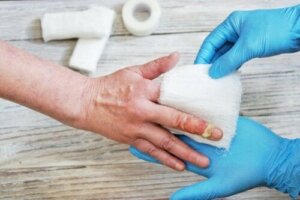First Aid Treatment for Hot Water Burns


Written and verified by the doctor José Gerardo Rosciano Paganelli
Hot water burns are one of the most common household accidents. These types of burns occur mainly in the kitchen when handling pots that are difficult to grip. Also, if we’re not paying enough attention. In some cases, the burn may occur as a result of a poor grip on a pot, cup, or other containers.
Generally, hot liquids can easily spill on our skin and burn it, especially when we’re careless. In those cases, you must take into account that your priorities for action are as follows:
- Ease the pain
- Keep the burn from expanding
- Promote good healing
Some of the most serious accidents occur at home. Falls, bumps, burns, and electricity incidents are common, especially when there are children around.
Today we’ll give you some tips and we’ll also explain the first aid measures to treat hot water burns.
Read about Fenistil: A Great Remedy for Stings, Burns, and Hives

Types of burns
Before deciding on the treatment for your burn, know there are three different degrees of hot water burns, a greater number indicates a greater degree of severity of the burn:
- First-degree. These affect the superficial layer of the skin. The symptoms include redness, swelling, and a little pain. And, the area peels off within 7 days and is back to normal within two weeks.
- Second-degree. This type of burn reaches the second layer of the skin and cause blisters and inflammation. In addition, healing takes place in about three weeks. However, the skin often ends up a little lighter or darker after scarring.
- Third-degree. This is the most severe type of burn and is an emergency that requires immediate medical care. The burn goes through all your skin layers and is extremely painful.
Don’t forget to read The 7 Best Natural Remedies for Reducing Scars
Burns from boiling water
These are the most common domestic accidents. A pot of boiling water on the stove is a real danger and could even turn into a tragedy when there are kids around. Small though serious burns caused by boiling water are also common.
You should always be careful and take some precautions such as:
- Be careful when uncovering pots and when grabbing containers with hot liquids in the microwave
- Always place the pots as far away from the edge and with the handles inwards when you cook
- Be very careful when opening the oven door
If boiling water just splashes you or has very light contact with your skin, it will cause a bit of pain, but this will disappear in no time. A good idea to stop the burning is to run cold water over the area.
However, if the burn is more severe and the pain doesn’t go away and there’s more redness and blistered then you must seek medical attention. In addition, don’t burst the blisters to prevent a major injury or infection.
Don’t try to remove your clothes if they’re stuck to your skin. Instead, wet them with cold water and go immediately to your closest ER.

Treatment for hot water burns
We have already said that you must act quickly and assess the damage when it comes to a hot water burn.
When you’re sure it’s a first-degree burn (superficial) then follow these steps:
- Cool the wound down with plenty of cold water.
- Apply a wet bandage on the affected area, keep it between half an hour, and keep the burn away from contacting any harmful agents
- Take an anti-inflammatory for pain.
- Moisten the bandages before removing them so they don’t stick to your skin.
- After 7 days, clean and remove any dead skin using a saline-wet gauze.
You must go to the doctor for an evaluation and treatment according to the type of burn that may have occurred if there’s still pain or other discomforts after applying all these measures.
Remember it isn’t advisable to use poultices and ointments with herbs or aloe vera as not all types of skin are the same. That is not everyone reacts favorably to the same substances, even if these are natural. Instead of providing relief, they may lead to further discomfort in many cases.
All cited sources were thoroughly reviewed by our team to ensure their quality, reliability, currency, and validity. The bibliography of this article was considered reliable and of academic or scientific accuracy.
- Belmonte Torras, J. A., Marín De La Cruz, D., Gornés Benajam, M. B., Gubern Pi, L., & Guinot Madridejos, A. (2004). Quemaduras por agua caliente sanitaria. Anales de Pediatria. https://doi.org/10.1157/13068030
- Local, T. (2014). Tratamiento de las quemaduras. Universidad Computense de Madrid.
- Moliné, J. y S. M. (1999). Primeros auxilios : quemaduras. NTP 524: Primeros Auxilios: Quemaduras.
This text is provided for informational purposes only and does not replace consultation with a professional. If in doubt, consult your specialist.








